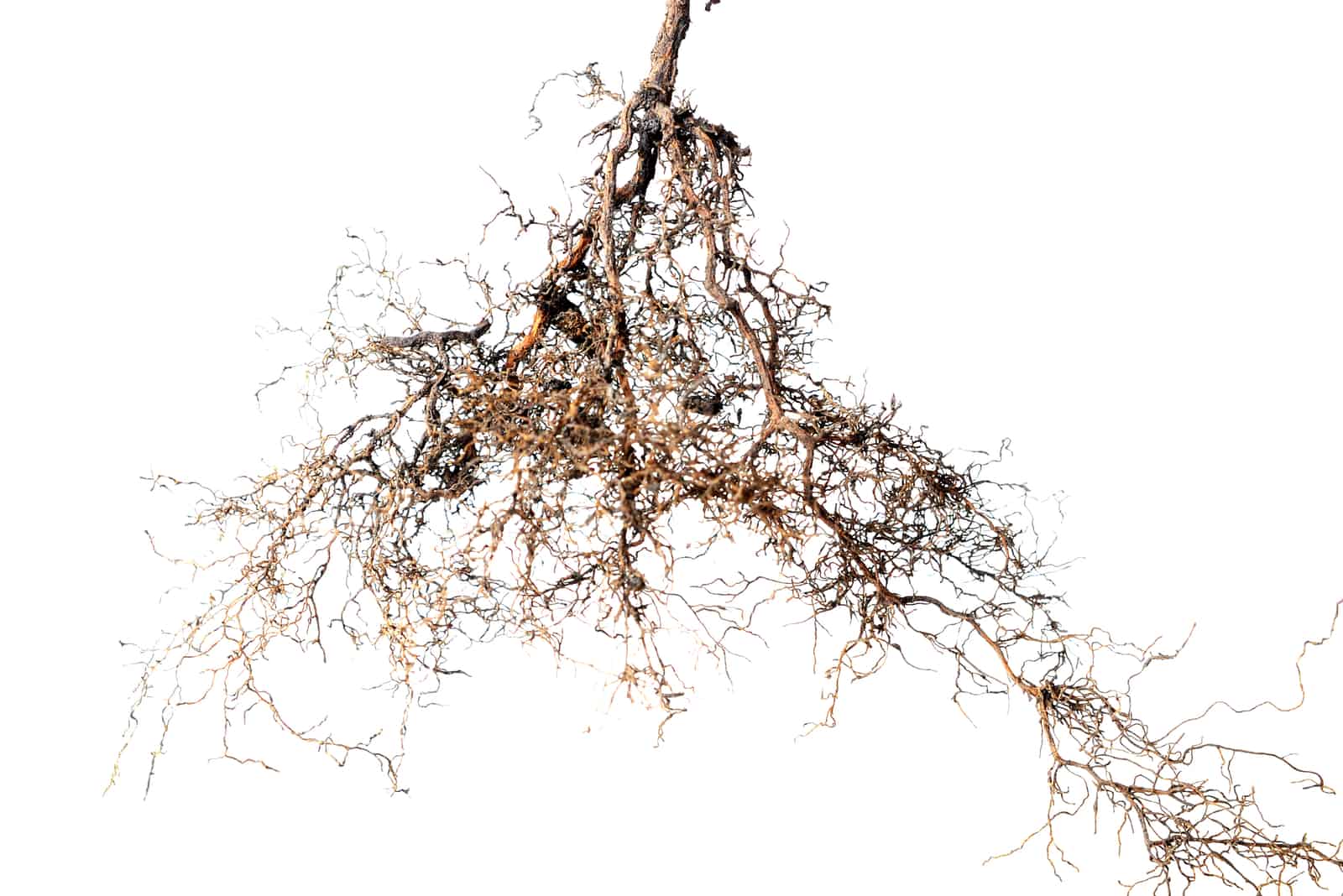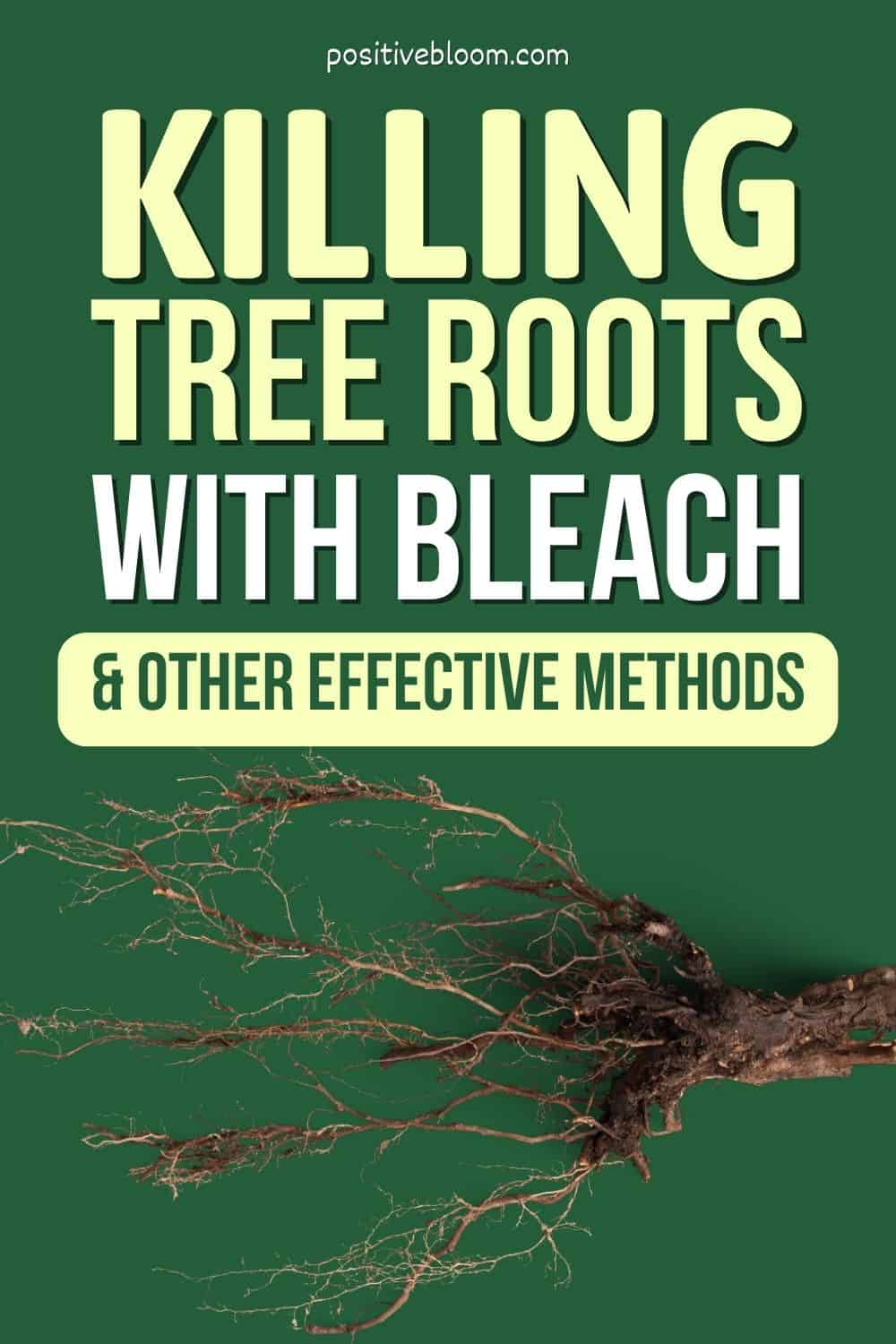Many arborists dread it, and we’re not so keen on doing it either, but killing tree roots with bleach or some other chemical can sometimes be necessary.
For example, if the tree roots find their way into your sewer line, you won’t be able to remove them without killing them. You may be able to find a way, but it almost certainly won’t be worth the effort.
That is why we decided to write this article about the best ways of killing tree roots and stumps. Sometimes they’re simply in the way or tainting your landscape design, so you have to get rid of them somehow.
This article will teach you some of the most effective ways of removing tree stumps and roots, and also examines their pros and cons so you can decide exactly how you want to remove those unwanted trees and stumps.
Killing Tree Roots With Bleach
Bleach is not the most effective tree killer, but it is something found in every household and we all know that it can harm you, your plants, and even trees.
However, trees don’t absorb it very well, and whereas it may kill some tree roots, more resilient trees can survive being attacked with bleach and regrow new shoots and roots in no time.
If tree roots invade your sewer line you can try killing them with bleach, but you will most likely have to repeat the process many times before you get the desired result. Also, bleach cannot dissolve tree roots, so you’ll still have to remove them manually.
Another downside of bleach is that it is highly corrosive, so if your pipes are made of metal this method will only cause more issues.
However, if your pipes are made of a stronger material, using bleach shouldn’t harm them. The best way to kill tree roots with bleach is by cutting the roots, drilling holes in them, and spraying them with bleach.
To localize the damage, you can also paint bleach with an old paintbrush into drilled holes. This will probably take a few applications and the results aren’t 100% guaranteed.
Thankfully, there are some other ways of removing tree roots, so if the bleach doesn’t work there are things you can try before giving up, selling your house, and moving across the country!
How Long Does Bleach Take To Kill A Tree?
Before we get into any more detail about other ways of getting rid of tree roots, let’s look at how long it takes for bleach to kill a tree.
When you apply a bleach solution of a 1:1 ratio of water and bleach, it will dry out the leaves within 10 minutes.
However, it’s highly likely that most trees, especially hardy varieties, won’t be killed by this process. It may take many months just to kill a stump, let alone a whole tree. Therefore, a better option would be to cut the tree down and then remove the stump.
DIY solutions to killing trees don’t always work, even though they will kill moss on tarmac and other smaller plants. It’s basically a trial and error method, so you might need to kiss a few frogs to find your prince, so to speak.
Will Bleach Hurt Trees?
Yes, bleach can hurt trees, and if your intent isn’t to kill the entire tree, but rather just a few of its roots, you need to be extra careful.
Tree leaves turn brown, wilt, and drop 10 minutes after applying a bleach solution, so it’s safe to say that it can harm your tree!
On the bright side, if bleach does touch the tree bark you can simply neutralize it with water and relax knowing that your tree is safe and sound.
Other Ways Of Killing Tree Roots
There are plenty of home remedies to try before giving up and calling a specialist.
In this section, we’ll discuss some common ways of removing tree roots and see whether they actually work, or if there’s a catch like with bleach.
Epsom Salt
Epsom salt is another common way of removing tree roots, and it is a compound of magnesium and sulfur that occurs naturally.
Even though plants can tolerate it in small quantities (and some even love it), it can prove fatal if a large amount of Epsom salt finds its way to your tree roots. (Just what we need, right?)
Fill a bucket with 3 gallons (11L) of water and dilute around 15 cups (approximately 3 kg) of Epsom salt in it. Use a trowel to dig around the stump and try to reveal the roots. Use a drill to make holes in the roots in all directions and fill them with the Epsom salt solution.
You’ll need to repeat this process until you notice the roots have started to dry out. Once the root system is dry, you can cut them out or even uproot the entire stump.
The important thing is to apply the Epsom salt to live tissue so that it can be transferred to the roots’ ends.
Rock Salt
Using rock salt is a popular way of getting rid of tree roots from a sewer or pipes. It does seem too good to be true, but many claim it works. You simply have to flush some rock salt down the toilet, and that’s pretty much it.
You need about 2 pounds (900 g) of rock salt, but you shouldn’t flush it all at once. It can be quite harmful to your tree and end up killing more than just the roots invading your sewer line.
First, take half a pound (225 g) and flush two or three times, and then flush the rest of the rock salt. You should repeat the process again two weeks later just to ensure that the tree roots are dead and gone.
Copper Sulfate
Copper sulfate is another compound that can be used to kill tree roots in your sewer line, but it’s not likely you’ll have it laying around your home unless you’ve had a tree invasion before.
However, it is an effective root killer, fungicide, herbicide, and algaecide, so it can kill pretty much everything, from microscopic fungi and weed sprouts to tree roots.
Copper sulfates are quite easy to use. Just pour half a cup (159 g) of the blue crystals into the toilet and then flush the water a few times.
How To Kill A Tree Stump
It’s not uncommon to see some trees grow too tall and mess with power cables or shade a lawn so grass can’t grow the way it should. In that case, felling trees is justified. However, you’re left with an ugly stump, and unless it’s the right size to be turned into a small outdoor table, it needs to go.
This section contains some effective tree stump removal methods.
See for yourself!
Stump Grinder
If you have felled several trees (and hopefully planted new ones in a different location), the best way to remove them is by renting a stump grinder.
However, if you only need to remove one tree stump there are cheaper ways of doing it because renting a stump grinder can be really pricey.
You can cover the cut stump in compost and then uproot it the following year when it has dried and rotted. Or you can attack the stump immediately and try to pry it out, but that requires some serious muscle.
Potassium Nitrate
Potassium nitrate, or saltpeter, is one of the fastest methods of getting rid of tree stumps, except for a stump grinder. What would usually take years is now reduced to a month or six weeks.
This compound is a highly effective stump killer, but you have to know how to use it. You first need to drill some holes at least 4 inches deep and apart with a drill bit, and then fill them with saltpeter. After that, slowly pour hot water into the holes so the potassium nitrate can do its job. Fill the holes again if necessary.
You can cover the stump with some mulch to speed up the process if you like. However, there is a downside to using saltpeter: it’s not always so easy to find, so if you get a chance to buy it at a reasonable price, don’t hesitate.
Here’s a video that will guide you through the entire process:
Chemical Herbicide
Killing tree stumps with herbicides is among the top 3 ways of removing them. Brush killers with 50% glyphosate concentrate are a great stump killer, and don’t get me started on Tordon; that thing can kill tree trunks and whole trees, not just stumps!
If you need to kill a tree below 15 feet (4.5 m) tall for whatever reason, you can use systemic herbicides like Roundup.
These herbicides are effective because they get carried to the roots’ ends, where they attack the natural biological processes of plants.
Copper Nails
Copper nails (or any other tool made of pure copper) are said to kill tree stumps, but we have a hard time believing it. However, the science behind it isn’t that far-fetched and actually makes sense.
You have to hammer some copper nails into the stump close to the ground, and the size of the stump determines how many nails you’ll need.
Then cover the nails with soil so they can oxidize and release copper oxides, which are harmful to plants. It might take a while, but you can uproot it and enjoy your clean garden once the stump dies.
Bleach
The last method of removing tree stumps is by using bleach. It is a controversial subject, and the most important question here is whether bleach works, or in other words, will bleach kill a tree stump?
The crucial thing is to expose the living tissue of the tree, as bleach only affects the weakest areas like the cambium layer and leaves.
Therefore, if your stump has been there for a while you should use a chainsaw to reveal the live tissue or drill holes in the outer layer for better results. Fill the holes with bleach or paint it on the live tissue and leave it to do its magic.
You can pry the stump out when you notice that no new branches are growing from the tree trunk. However, if new shoots do continue their growth, it’s likely your cue to switch to Tordon or some other herbicide that will definitely get the job done.
You Asked Us
Now we come to our favorite section: answering your questions! We realize that not every topic can be covered in one article, so we found some of the most common questions you’ve asked and answered them.
Let’s see what you’ve got in store for us!
What household products kill tree roots?
We’ve already mentioned some of the most common household products used to kill tree roots and stumps, such as Epsom salt, rock salt, and bleach. However, there are some other ingenious ways of killing trees.
You can kill them with a durable black trash bag or a large, dark bucket. If you cover the tree stump with a black trash bag or black bucket to block out the sunlight and moisture, you should start seeing results in a few months.
You can also use white vinegar, but it might prove cost-inefficient. You have to spray it frequently onto the stump in large quantities for this to work. And you’ll have to do it until the part that supplies the roots with nutrients (and is usually leafy) dies, and the rest of the roots along with it.
How do you permanently kill tree roots?
The fastest and most promising way to kill tree stumps and roots is by using chemical herbicides. The best herbicides for this purpose are triclopyr and glyphosate. You just have to find the percentage that suits you, and your garden will soon be tree stump and root-free.
How do you kill tree roots in an established garden?
The best way of killing tree roots in gardens is by minimizing the damage, which means that you should drill holes in the stump or roots and only fill them with chemicals.
This will prevent leakage onto other plants and keep your flora safe. After you have drilled holes, you can fill them with whatever you like, whether it’s bleach or potassium nitrate.
Also, hammering some copper nails into a tree stump is an excellent way of damage control, as it won’t hurt the surrounding plants, but it will kill the stump.
Finally, covering the tree stump with a black trash bag is definitely the safest way of killing stumps as it won’t leak any chemicals into the soil that will harm your other plants.
Be careful when using Epsom and rock salts as they can leach into the soil and cause a lot of damage.
Final Thoughts
This article explained the best ways of killing tree roots with bleach, but we also saw some other techniques of killing roots and stumps that may be even more effective.
As you now know, you have to put work into drilling holes and be patient because none of the solutions work overnight (except for the stump grinder).
We urge you to be careful when handling herbicides and other chemicals as they can harm the surrounding plants as well. If you only want to rid your sewer line of tree roots and not kill the entire tree, you need to control the amount of chemicals you’re using and where you use them.
We do hope that you found these tips helpful, and if there are some others that you’re aware of that work, let us know in the comments below!
Good luck and until next time!
Like this post? Share or pit it for later!





